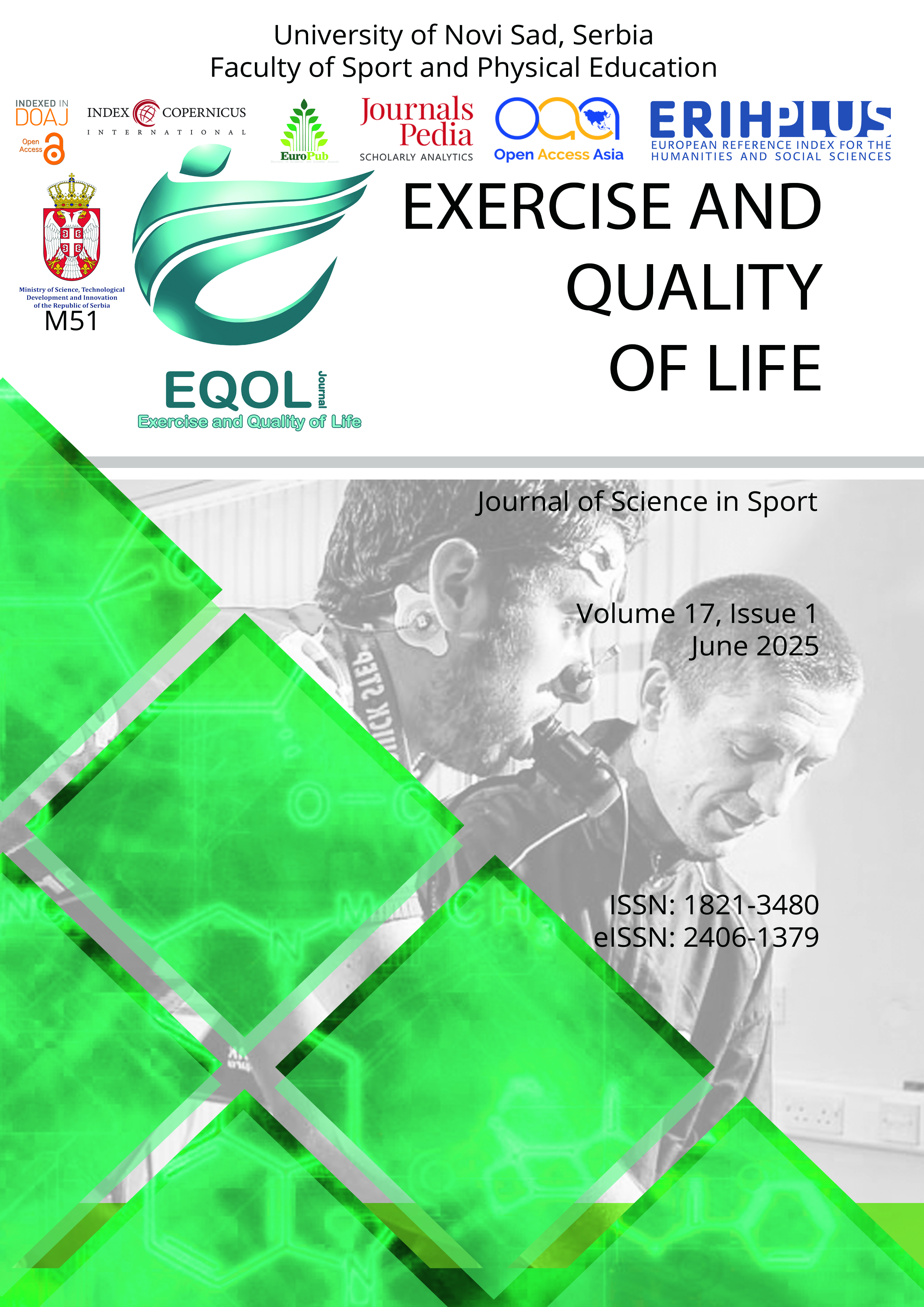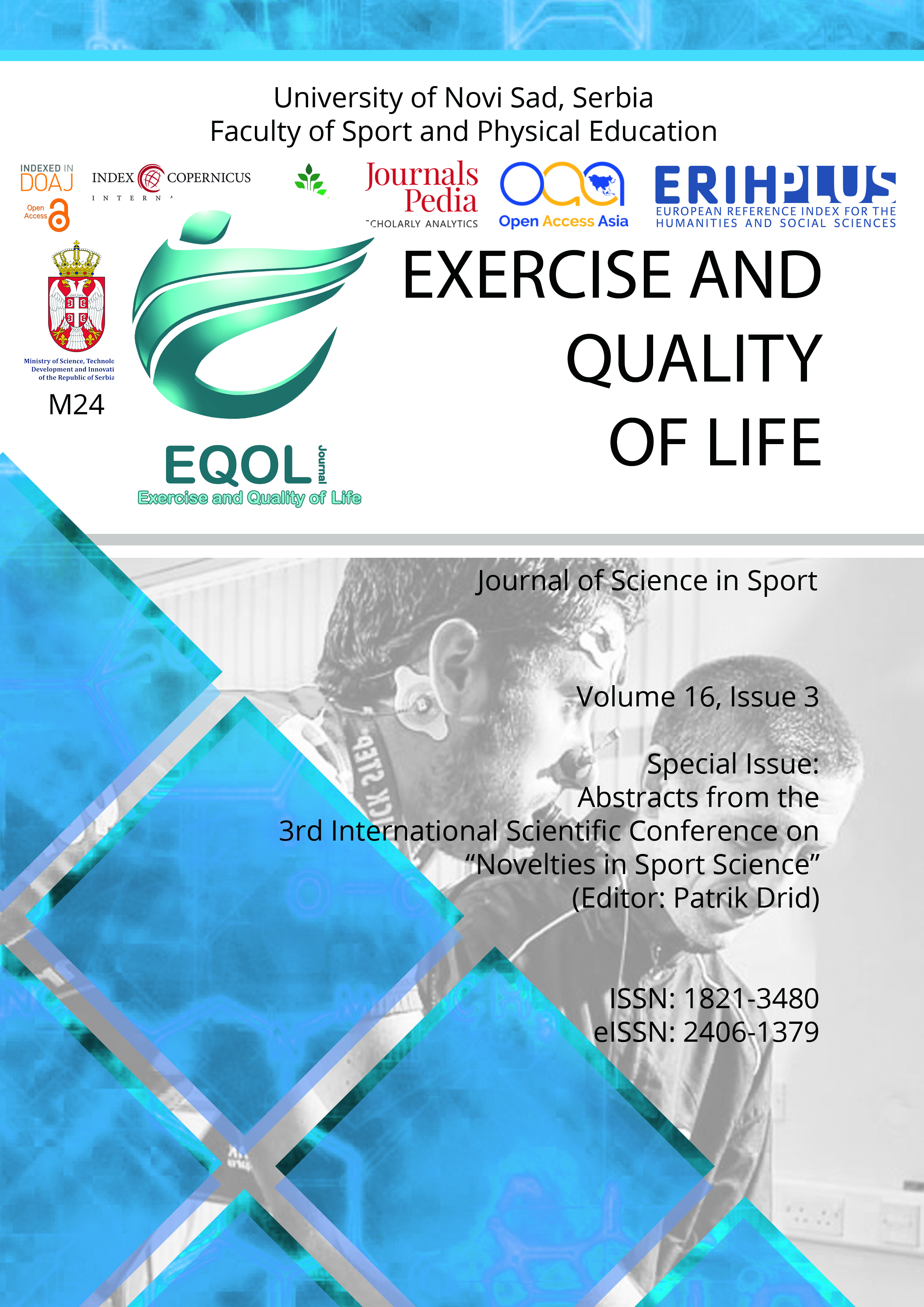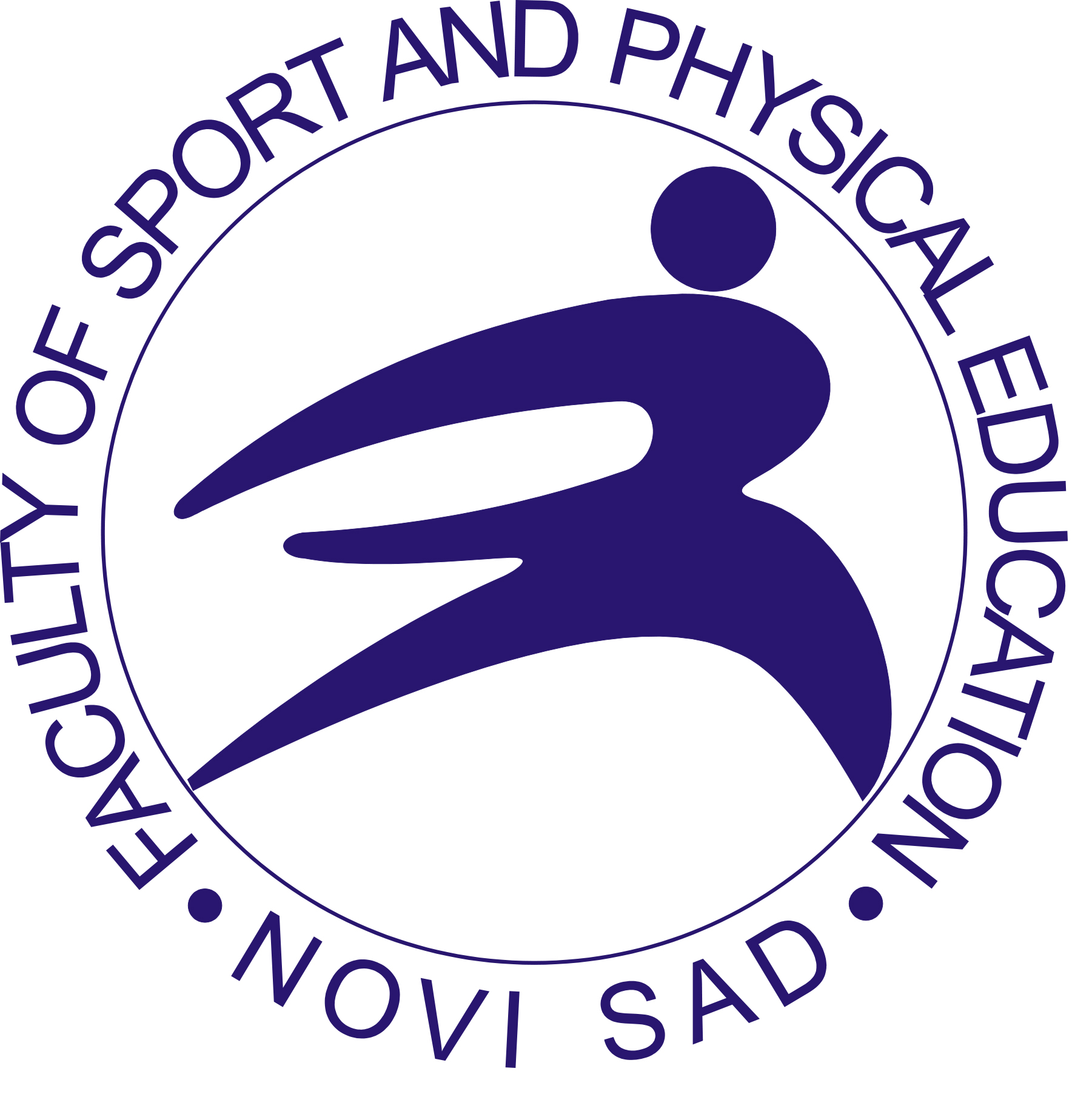Current issue

Volume 17, Issue 1, 2025
Online ISSN: 2406-1379
ISSN: 1821-3480
Volume 17 , Issue 1, (2025)
Published: 15.06.2025.
Open Access
All issues
Contents
22.01.2025.
Original scientific paper
Comparison of the effects of isoinertial and traditional strength training in male tennis players
The goal of the research was to determine the effects of six weeks of isoinertial training on explosive strength, speed, and agility compared to traditional strength training in tennis players. The subjects, thirty male tennis players aged 20 to 35, were divided into three groups: the experimental group 1 (E1; n=10), which performed strength training on an isoinertial device; the experimental group 2 (E2; n=10), which performed traditional strength training; and the control group (C1; n=10). E1 and E2 groups had a total of six weeks of training with two training sessions per week, with three exercises per training session performed in four series for six to eight repetitions. The results showed that isoinertial strength training has a positive effect in the variables squat jump (SJ), countermovement jump (CMJ), 5-meter sprint (5M), 20-meter sprint (20M), agility T-test (T-test), and 505 agility test (505). Post hoc analysis revealed that there are significantly better effects of isoinertial training compared to isodynamic training in the countermovement jump (CMJ), 5-meter sprint (5M), and 20-meter sprint (20M). The E1 group had significantly better results than the C1 group in all tests. The E2 group had significantly better results compared to the C1 group in the variables SJ, 20M, and T-test. The results also show that six weeks of isoinertial training produce better results in the development of variables CMJ and 20M compared to the traditional strength training group. Accordingly, fitness and tennis coaches should also use this training method when working with tennis players.
Dušan Ćorilić, Boris Karasek, Mladen Mikić
15.06.2024.
Original scientific paper
Effectiveness of EMMETT technique on Iliotibial band tightness in football players
The EMMETT technique, developed in Australia, is a manual therapy method gaining recognition for its non-invasive approach and reported effectiveness. This study aims to determine the impact of the EMMETT technique on iliotibial band (ITB) flexibility in young male football athletes. A total of 43 athletes (age 17.21 ± 1.99 years) were randomly assigned to either a control group (n=22) or an experimental group (n=21). The experimental group received the EMMETT technique, while the control group remained in a side-lying position for one minute. ITB flexibility was measured using the EasyAngle® goniometer through the Ober test before and after the intervention. The results showed a significant increase in ITB flexibility in the experimental group compared to the control group. Despite the positive findings, the study has limitations, including a small sample size, focus on a specific demographic (young male football players), and short-term assessment. Future research should include larger, more diverse populations and long-term follow-up to validate these results and explore the broader applications of the EMMETT technique. This study supports the potential of the EMMETT technique as an effective manual therapy for improving ITB flexibility.
Teo Radić, Jelena Paušić, Mario Rak
15.12.2024.
Original scientific paper
The relationship between primitive reflex profile and development of vestibular maturity in early school years
Previous research indicates that vestibular perception is related to muscle tone regulation. Muscle tone influences auditory and visual perception. Research findings suggest that the functioning of primitive reflexes affects the maturation and condition of the vestibular organ. The goal of the study is to examine whether the primitive reflex profile can be influenced by appropriate exercises and whether inhibition of persistent primitive reflexes affects vestibular functions. The sample consisted of 506 children aged 5–8 years (237 boys and 269 girls). In kindergartens and schools, 443 participants performed reflex inhibition exercises 3–5 times a week for 7 months. A control group of 63 individuals attended only regular PE lessons. Input and output results were compared using the Mann-Whitney test, and effect sizes were calculated. Input primitive reflex profile and vestibular maturity: not significant. Effect size: primitive reflex profile: 0.109; vestibular maturity: 0.052. Output: primitive reflex profile: p <0.001; vestibular maturity: p <0.001. Effect size: primitive reflex profile: 0.572; vestibular maturity: 0.306. The results obtained with appropriate non-parametric measurements show that children participating in the intervention achieved statistically significantly higher scores in all tested variables of primitive reflex profile and vestibular maturity compared to the control group. The children in the intervention group showed significant improvement in both primitive reflex profile and vestibular maturity: p <0.001; effect size: primitive reflex profile: 0.714; effect size: vestibular maturity: 0.664; while there was no significant improvement in the control group: effect size primitive reflex profile: 0.01; vestibular maturity: 0.06. We found a strong, significant correlation between the inhibition of primitive reflexes and vestibular maturity: r=0.000; rho (ρ)=0.000. Based on this study we recommend incorporating these exercises into physical education for 5–8-year-old children.
Erzsébet Stephens-Sarlós
09.12.2024.
None of above
Abstracts from the 3rd International Scientific Conference on “Novelties in Sport Science”
We are delighted to invite you to the 3rd International Scientific Conference “Novelties in Sport Science.” This event serves as a premier platform for researchers, practitioners, and enthusiasts to exchange ideas and explore the latest advancements in sports science.
The conference showcases a diverse range of topics, reflecting the dynamic and evolving nature of this field. From the role of probiotics in athletic performance to the ethical contrasts between martial arts and Western sports, the proceedings highlight a balance between tradition and innovation. Cutting-edge tools like the "Ski Easy" methodology and transformative findings in injury prevention and active aging underscore the impact of science on physical activity and health.
This year, special attention is given to sustainability and inclusivity. Presentations on sustainable sports tourism in Vojvodina and environmentally responsible sports practices emphasize the alignment of sports science with the United Nations' Sustainable Development Goals. Other contributions delve into the intersection of education and technology, exploring topics such as teaching English to sports professionals and using wearable devices to enhance cardiovascular health.
The global contributions at this conference reflect a shared mission to foster collaboration and innovation. From improving injury recovery to engaging youth through cognitively enriched activities and advancing talent identification tools, these studies demonstrate the power of sports science to enhance quality of life across diverse populations.
We extend our sincere gratitude to the authors, reviewers, and organizing committee for their invaluable efforts. Let this event inspire meaningful dialogue, foster international partnerships, and drive new advancements in our field.
Together, we continue to push the boundaries of sports science, ensuring its relevance in an ever-changing world.
Patrik Drid and Damjan Jakšić
Patrik Drid, Damjan Jakšić
15.12.2024.
Original scientific paper
Subjective assessment of sedentary behavior between theory and practice: Pilot study using the “Sedentary meter”
Although sedentary behavior (SB) is still an under-researched area, some studies have shown a significant association between prolonged sitting and an increased risk of mortality, due to various causes, independent of physical activity. Despite the health risks, there are currently no specific guidelines for individuals to self-assess their SB. A pilot observational study was conducted as part of the »Knowledge for Health« event. A short online quiz “Sedentary meter” was developed, consisting of a pictorial scale to help event participants assess their daily sedentary time and to promote a better understanding of the associated health risks. The quiz questions were formulated based on the WHO definition of SB. The participants’ task was to subjectively estimate the amount of sedentary time in various types of SB on a typical day. The results obtained for SB could then be immediately compared with the figurative scale based on the WHO guidelines. The analysis confirmed SB (533.0±224.7 min/day) in all age groups, although possible differences according to the type of SB were noted. Despite statistically non-significant differences, those between age groups may indicate the extent to which SB can be individualized. The differences between age groups may indicate the importance of considering SB which can be targeted based on each age group's daily routine. The simple tool for accessing SB raised awareness of which specific type of SB accounts for the majority of participants' daily sedentary time. The self-critical acceptance of the “poor results” across all age groups shows the effectiveness of the initiative in raising awareness of SB issues.
Ana Cikač, Kaja Teraž, Saša Pišot
15.12.2024.
Original scientific paper
Game-related statistics that discriminate between winning and losing u-17 men's and women's basketball teams
The purpose of the present study was to compare game-related statistics between men's and women's under-17 (U-17) basketball teams and to identify game-related statistics that discriminate between winning and losing teams for both sexes. Games with a final score difference greater than 30 points were excluded from the analysis, so the final sample consisted of 196 games (109 men's and 87 women's games) from the 2022/2023 season of the Triglav Cadet League of Serbia. The following game-related statistics were gathered from the official box scores of the Basketball Federation of Serbia: 2- and 3-point field-goals (successful and unsuccessful), free throws (successful and unsuccessful), defensive and offensive rebounds, assists, steals, turnovers, blocks (committed and received), and fouls (committed and received). Men's teams had significantly better values than women's teams in successful and unsuccessful 2-point field-goals, successful 3-point field-goals, successful and unsuccessful free throws, assists, and turnovers. Women's teams had statistically better values than men's teams in unsuccessful 3-point field-goals, offensive rebounds, steals, and committed fouls. The discriminant factors between winning and losing teams in close games, were successful 2-point field-goals, defensive rebounds and assists for both sexes, and offensive rebounds for men's teams. In balanced games, discriminant factors were assists for both sexes and successful 2-point field-goals for women's teams. In unbalanced games, discriminant factors were assists for both sexes, defensive rebounds for men's teams, and successful 2-point field-goals for women's teams. These findings suggest that there are notable differences in game-related statistics for U-17 men's and women's basketball teams.
Boris Karasek, Mladen Mikić
15.06.2024.
Review scientific paper
Musculoskeletal injuries in bodybuilders: A brief review with an emphasis on injury mechanisms
In this article we reviewed the literature on injuries and their mechanisms in bodybuilders. Bodybuilding is a weightlifting sport where the main goal is to increase muscle mass while maitaining body symmetry. From a biomechanical point of view, it is important to analyse technical performance of exercises to improve sports technique. Compound exercises based on the development of muscle hypertrophy must be included. The training is different before and during season, in pre-season it is based on reduction of body fat to a low level and a high volume of aerobic exercise. Adequate nutrition, use of supplements and banned substances are widespread in the sport. In that case athletes should be very careful for banned substances in accordance with WADA Code. The most commonly performed exercises where injuries happen are the squat, deadlift and benchpress. The majority of injuries (60 %) are acute, with 93 % shoulder joint injuries, 85 % lower back injuries and 80 % knee injuries. The incidence of injuries is low compared to other sports, between 0.24/1000 hours of training or 0.12 injuries per lifter per year. The most common type of injury is muscle strain, followed by tendinitis and cartilage wear. So it is therefore important to identify risk factors to allow the development of appropriate prevention programs. Muscle ruptures are common with high eccentric loads, with pectoralis major tendon being the most vulnerable to be injured. Than followed by a rupture of biceps femoris during the deadlift exercise, during sudden flexion of the hip joint while the knee is extended. Eccentric contraction and rupture also occurs in the quadriceps muscle, which lifters try to avoid by performing low-bar squat. Uncontrolled abdominal pressure during high-weight exercises causes discus hernias, which lifter can prevent by breathing correctly and using strong muscle stabilizers. The most well-known injury of all is elbow burzitis or »Bodybuilders elbow« due to repetitive flexion and extension movements of elbow joint. To prevent this injuries we have to include preventive measures such as medical check-ups, education of athletes, ensuring safety in competitions, appropriate training and load distribution, treating the body as a whole and regular equipment check-ups.
Valentina Franca, Jana Harcet
15.06.2024.
Original scientific paper
Correlation between acute muscle damage and oxidative protection enzymes during different aerobic exercises
Different types of aerobic exercise can cause different disorders of homeostasis. This cross-over experiment aimed to determine the muscle fatigue and the antioxidative protection of female basketball players following a load caused by three different aerobic-type exercises (low-intensity continuous, high-intensity continuous, and high-intensity interval training). Twelve female basketball players (age 17.7±4.3 years; weight 67.3±9.8 kg; height 178.0±7.4 cm) voluntarily participated in the study. A wash-out period of 7 days between single sessions of different training was provided. Venous blood was drawn right before and immediately after each exercise session. The parameters that were analyzed are markers of muscle damage and enzymes of antioxidant protection. As a marker of muscle damage, myoglobin (F=2.884; p=0.065) and lactates (F=5.254; p=0.008) have higher values and statistically significant differences between training types. Creatinine shows higher values after each training session (F=4.053; p=0.022). Results of enzyme activity for oxidative protection show statistically significant differences between groups for catalase (F=5.811; p=0.005) with different types of training intervention. At the beginning of the preparatory period, parameters of acute muscle damage values are high. During the season, in response to different types of training, those parameters decrease in response to the body's adaptation to exercise-induced stress. Training leads to maintenance of physiological balance in the body and oxidative stress is not a necessary phenomenon of high aerobic training load. The inclusion of antioxidant protection enzymes decreases as the body adapts to a certain type of exercise.
Bojana Marić, Sandra Vujkov
15.06.2024.
Original scientific paper
Sports injuries in athletes with disabilities
The aim of the study was to determine the type and localization of sports injuries in people with disabilities who play sports professionally or recreationally and to examine whether there was a difference in sports injuries between these two categories of para-athletes. The research sample consisted of 30 men with an average age of 40.96 years. The sample had two subsamples. The first group consisted of 13 respondents who participated in para-sports professionally. The second group comprised of 17 respondents who take part in para-sports recreationally. The respondents trained individual and team para-sports (parashooting, parataekwondo, paraswimming, paracycling, para-athletics, para-table tennis, sitting volleyball and wheelchair basketball). A questionnaire was created to gather overall demographic data, and a part of the Musculoskeletal Discomfort Form was used to localize musculoskeletal complaints. Descriptive statistics, measures of central tendency, the Mann-Whitney U test and Spearman's rank correlation coefficient were applied. The results showed that 76.6% of all para-athletes have suffered at least one injury, with most injuries occurring during training (63.3%). Shoulder trauma and soft tissue injuries were the most common. Both subsamples reported that they had experienced the most problems in the form of pain, discomfort and numbness in the neck and lower back. As far as people with disabilities are concerned, participation in para-sports carries inseparable and associated risks. Therefore, the data achieved in this study can be used in order to understand the risk factors leading to injury which are specific to para-athletes (disability-sport) and to develop injury prevention programs.
Ivana Sretenović, Goran Nedović, Srećko Potić
15.06.2024.
Professional paper
Effect of low-dose radiotherapy in rotator cuff calcific tendinitis: A case report
Rotator cuff calcific tendinitis (RCCT) is an acute or chronic painful condition due to the presence of calcific deposits inside or around the tendons of the rotator cuff. Effective treatment of RCCT is crucial for restoring shoulder function, alleviating pain, and enhancing the patient’s quality of life. The treatment of RCCT is mainly divided into surgical and non-surgical treatment. Conservative treatment has been regarded as the first-line therapy, but the effectiveness of these treatments is still not well-established. When conservative treatment fails, invasive treatment, either minimally invasive or surgical, is usually indicated. Nowadays, low-dose radiotherapy has been used for the treatment of various benign conditions, including calcific tendinitis. We presented a 56-year-old female patient with intense pain and limited mobility of her left shoulder. X-rays and ultrasound of the left shoulder showed a massive oval calcification along the greater part of the m. supraspinatus measuring 41x8mm. The patient was first treated with diclopram, peranton gel, and rest. After that, it was decided to try low-dose radiotherapy. It was performed on the Vitalbeam radiotherapy platform with a conformal technique in doses of Gy 8 and 10 fractions. After the last fraction, the pain gradually disappeared and mobility was regained. The ultrasonography control 2 months after the last session showed the total disappearance of the calcification. The use of low-dose radiotherapy for benign conditions is a topic of ongoing debate in the medical community. In this case, low-dose radiotherapy proved to be an adequate method of choice without accompanying side effects, resulting in complete healing and improvement of quality of life.
Nataša Milenović, Sonja Lukač, Silvija Lučić, Vedrana Karan Rakić, Daniel Slavić, Đurđa Cvjetković Nikoletić, Damir Lukač





























